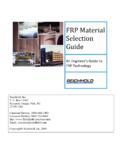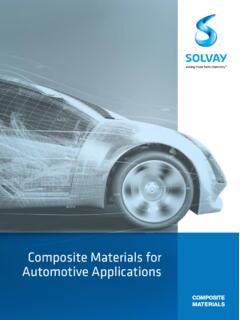Transcription of GUIDE TO COMPOSITES - Gurit
1 GUIDE TO THE FUTURE OF composite SOLUTIONSGTC-6-0417 - 1 Contents1. Introduction 4 Basic composite theory 4 Polymer matrix COMPOSITES 42. Designing with COMPOSITES 6 Loading 6 Tension 6 Compression 6 Shear 7 Flexure 7 Stress or strain? 7 Fibre orientation 10 Fatigue Resistance 103. Monolithic laminates 10 Rule of mixtures 10 Laminate theory 12 Laminate notation 134.
2 Sandwich panels 132 - GTC-6-04175. Material selection 14 Resin matrix 14 Polyester Resins 15 Vinylester Resins 18 Epoxy Resins 19 Comparison of Resin Properties 20 Other Resin Systems used in COMPOSITES 23 Fibres 24 Basic Properties of Fibres and Other Engineering Materials 25 Fibre Types 28 Fabric types 33 Unidirectional Fabrics 33 0/90 Fabrics 34 Woven Fabrics 34 Multiaxial Fabrics 37 Other Fabrics
3 39 Core materials for sandwich construction 40 Foam Cores 40 Honeycombs 42 Design considerations 456. Processing route 46 Spray Lay -up 47 Wet Lay-up/Hand Lay-up 48 Vacuum Bagging 49 Filament Winding 50 Pultrusion 51 Resin Transfer Moulding (RTM) 52 Other Infusion Processes - SCRIMP, RIFT, VARTM etc.
4 53 Autoclave 54 Oven 55 Resin Film Infusion (RFI) 56 GTC-6-0417 - 37. Secondary bonding 57 Science of adhesion 57 Mechanical interlocking 58 Diffusion theory 58 Adsorption theory 58 Weak Boundary Layers 58 Pre treatment prior to bonding 59 Adhesive selection 60 Epoxies and toughened epoxies 60 Polyurethanes 60 Acrylics and methacrylates structural adhesives 61 Polyesters 61 Urethane-acrylates 61
5 Heat stable adhesives: Bismaleimides, polyimides, cyanate esters 61 Anaerobics and cyanoacrylates 62 Joint design 628. Gelation, curing & post curing 639. Inspection and testing 63 Non destructive testing 64 Visual inspection 64 Tap testing 64 Ultrasonics 64 Computed Tomography 65 Shearography 65 Thermography 65 Lamb Wave Sensing 66 Radiography 66 Destructive testing 66 Mechanical testing 674 - GTC-6-0417 GUIDE to Structural CompositesIntroductionTo fully appreciate the role and application of composite materials to a structure.
6 An understanding is required of the component materials themselves and of the ways in which they can be processed. This GUIDE looks at basic composite theory, properties of materials used and then the various processing techniques commonly found for the conversion of materials into finished Basic composite TheoryIn its most basic form a composite material is one, which is composed of at least two elements working together to produce material properties that are different to the prop-erties of those elements on their own. In practice, most COMPOSITES consist of a bulk material (the matrix ), and a reinforcement of some kind, added primarily to increase the strength and stiffness of the matrix.
7 This reinforcement is usually in fibre form. Today, the most common man-made COMPOSITES can be divided into three main groups:Polymer Matrix COMPOSITES (PMC s) These are the most common and will be dis-cussed here. Also known as FRP - Fibre Reinforced Polymers (or Plastics) - these materials use a polymer-based resin as the matrix, and a variety of fibres such as glass, carbon and aramid as the Matrix COMPOSITES (MMC s) - Increasingly found in the automotive industry, these materials use a metal such as aluminium as the matrix, and reinforce it with fibres, or particles, such as silicon Matrix COMPOSITES (CMC s) - Used in very high temperature environments, these materials use a ceramic as the matrix and reinforce it with short fibres, or whisk-ers such as those made from silicon carbide and boron Polymer matrix compositesResin systems such as epoxies and polyesters have limited use for the manufacture of structures on their own, since their mechanical properties are not very high when compared to, for example, most metals.
8 However, they have desirable properties, most notably their ability to be easily formed into complex shapes. Materials such as glass, aramid and boron have extremely high tensile and compressive strength but in solid form these properties are not readily apparent. This is due to the fact that when stressed, random surface flaws will cause each material to crack and fail well below its theoretical breaking point . To overcome this problem, the material is produced in fibre form, so that, although the same number of random flaws will occur, they will be restricted to a small number of fibres with the remainder exhibit-ing the material s theoretical strength.
9 Therefore a bundle of fibres will reflect more accurately the optimum performance of the material. However, fibres alone can only exhibit tensile properties along the fibre s length, in the same way as fibres in a - 5It is when the resin systems are combined with reinforcing fibres such as glass, carbon and aramid, that exceptional properties can be obtained. The resin matrix spreads the load applied to the composite between each of the individual fibres and also protects the fibres from damage caused by abrasion and impact. High strengths and stiffnesses, ease of moulding complex shapes, high environmental resistance all coupled with low densities, make the resultant composite superior to metals for many PMC s combine a resin system and reinforcing fibres, the properties of the resulting composite material will combine something of the properties of the resin on its own with that of the fibres on their own.
10 Overall, the properties of the composite are determined by:i) The properties of the fibreii) The properties of the resiniii) The ratio of fibre to resin in the composite (Fibre Volume Fraction)iv) The geometry and orientation of the fibres in the compositeThe first two will be dealt with in more detail later. The ratio of the fibre to resin derives largely from the manufacturing process used to combine resin with fibre, as will be described in the section on manufacturing processes. However, it is also influenced by the type of resin system used, and the form in which the fibres are incorporated. In general, since the mechanical properties of fibres are much higher than those of resins, the higher the fibre volume fraction the higher will be the mechanical properties of the resultant composite .







